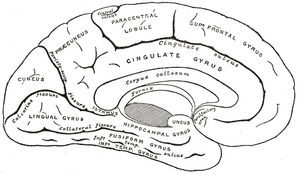No edit summary |
No edit summary |
||
| Line 1: | Line 1: | ||
| ⚫ | |||
| + | |||
[[Image:Gray727.png|thumb|300px|[[Gray's Anatomy|Gray's]] Fig. 727 - Medial surface of left cerebral hemisphere. ("Hippocampal gyrus" visible near bottom.)]] |
[[Image:Gray727.png|thumb|300px|[[Gray's Anatomy|Gray's]] Fig. 727 - Medial surface of left cerebral hemisphere. ("Hippocampal gyrus" visible near bottom.)]] |
||
The '''parahippocampal gyrus''' (or '''hippocampal gyrus''') is a [[grey matter]] [[cerebral cortex|cortical]] region of the [[brain]] that surrounds the [[hippocampus]]. This region plays an important role in the formation and retrieval of [[topographic | topographical]] [[memory]]. The parahippocampal place area (PPA) is a subregion of the parahippocampal gyrus that plays an important role in [[memory]] of scenes (rather than faces or objects). |
The '''parahippocampal gyrus''' (or '''hippocampal gyrus''') is a [[grey matter]] [[cerebral cortex|cortical]] region of the [[brain]] that surrounds the [[hippocampus]]. This region plays an important role in the formation and retrieval of [[topographic | topographical]] [[memory]]. The parahippocampal place area (PPA) is a subregion of the parahippocampal gyrus that plays an important role in [[memory]] of scenes (rather than faces or objects). |
||
| Line 7: | Line 9: | ||
{{Limbic system}} |
{{Limbic system}} |
||
{{Prosencephalon}} |
{{Prosencephalon}} |
||
| + | |||
| − | {{neuroscience-stub}} |
||
| + | |||
| ⚫ | |||
[[Category:Cerebrum]] |
[[Category:Cerebrum]] |
||
[[Category:Neuroanatomy]] |
[[Category:Neuroanatomy]] |
||
Revision as of 18:16, 4 December 2006
Assessment |
Biopsychology |
Comparative |
Cognitive |
Developmental |
Language |
Individual differences |
Personality |
Philosophy |
Social |
Methods |
Statistics |
Clinical |
Educational |
Industrial |
Professional items |
World psychology |
Biological: Behavioural genetics · Evolutionary psychology · Neuroanatomy · Neurochemistry · Neuroendocrinology · Neuroscience · Psychoneuroimmunology · Physiological Psychology · Psychopharmacology (Index, Outline)

Gray's Fig. 727 - Medial surface of left cerebral hemisphere. ("Hippocampal gyrus" visible near bottom.)
The parahippocampal gyrus (or hippocampal gyrus) is a grey matter cortical region of the brain that surrounds the hippocampus. This region plays an important role in the formation and retrieval of topographical memory. The parahippocampal place area (PPA) is a subregion of the parahippocampal gyrus that plays an important role in memory of scenes (rather than faces or objects).
External links
| Human brain: Limbic system | |
| Amygdala - Cingulate gyrus - Fornicate gyrus - Hippocampus - Hypothalamus - Mammillary body - Nucleus accumbens - Orbitofrontal cortex - Parahippocampal gyrus |
| This page uses Creative Commons Licensed content from Wikipedia (view authors). |